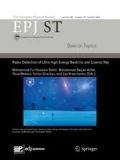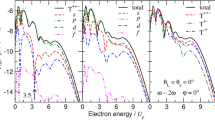Abstract
Single ionization of H\(_2\) molecules exposed to strong and short laser pulses is investigated by a semi-classical method. Three laser characteristics are considered: (i) The carrier-wave frequency corresponds to wavelengths covering and bridging the two ionization regimes: From tunnel ionization (TI) at 800 nm to multiphoton ionization (MPI) at 266 nm. (ii) Values of the peak intensity are chosen within a window to eliminate competing double ionization processes. (iii) Particular attention is paid to the polarization of the laser field, which can be linearly or circularly polarized. The results and their interpretation concern two observables, namely the end-of-pulse total ionization probability and vibrational distribution generated in the cation H\(_2^+\). The most prominent findings are an increased ionization efficiency in linear polarization and a vibrational distribution of the cation that favors lower-lying levels than those that would be populated in a vertical (Franck–Condon) ionization, leading to non-Franck–Condon distributions, both in linear and circular polarizations.







Similar content being viewed by others
Data availability
The datasets generated during and/or analyzed during the current study are available from the corresponding author on reasonable request.
Code availability
The Fortran codes developed by us and used in this work are available on request from the authors.
Change history
08 March 2023
A Correction to this paper has been published: https://doi.org/10.1140/epjs/s11734-023-00794-9
References
P.B. Corkum, F. Krausz, Attosecond science. Nat. Phys. 3(6), 381–387 (2007). https://doi.org/10.1038/nphys620
P. Lu, J. Wang, H. Li, K. Lin, X. Gong, Q. Song, Q. Ji, W. Zhang, J. Ma, H. Li, H. Zeng, F. He, J. Wu, High-order above-threshold dissociation of molecules. Proc. Natl. Acad. Sci. USA 115(9), 2049–2053 (2018). https://doi.org/10.1073/pnas.1719481115
P.B. Corkum, Plasma perspective on strong field multiphoton ionization. Phys. Rev. Lett. 71(13), 1994 (1993). https://doi.org/10.1103/PhysRevLett.71.1994
M. Lewenstein, P. Balcou, M.Y. Ivanov, A. L’Huillier, P.B. Corkum, Theory of high-harmonic generation by low-frequency laser fields. Phys. Rev. A 49(3), 2117–2132 (1994). https://doi.org/10.1103/PhysRevA.49.2117
T. Okino, Y. Furukawa, Y. Nabekawa, S. Miyabe, A.A. Eilanlou, E.J. Takahashi, K. Yamanouchi, K. Midorikawa, Direct observation of an attosecond electron wave packet in a nitrogen molecule. Sci. Adv. 1(8), 1500356 (2015). https://doi.org/10.1126/sciadv.1500356
S. Sukiasyan, S. Patchkovskii, O. Smirnova, T. Brabec, M.Y. Ivanov, Exchange and polarization effect in high-order harmonic imaging of molecular structures. Phys. Rev. A 82, 043414 (2010). https://doi.org/10.1103/PhysRevA.82.043414
T. Zuo, A.D. Bandrauk, P.B. Corkum, Laser-induced electron diffraction: a new tool for probing ultrafast molecular dynamics. Chem. Phys. Lett. 259(3), 313–320 (1996). https://doi.org/10.1016/0009-2614(96)00786-5
C.I. Blaga, J. Xu, A.D. DiChiara, E. Sistrunk, K. Zhang, P. Agostini, T.A. Miller, L.F. DiMauro, C.D. Lin, Imaging ultrafast molecular dynamics with laser-induced electron diffraction. Nature 483(7388), 194–197 (2012). https://doi.org/10.1038/nature10820
M. Peters, T.T. Nguyen-Dang, C. Cornaggia, S. Saugout, E. Charron, A. Keller, O. Atabek, Ultrafast molecular imaging by laser-induced electron diffraction. Phys. Rev. A 83(5), 051403 (2011). https://doi.org/10.1103/PhysRevA.83.051403
T.T. Nguyen-Dang, M. Peters, J. Viau-Trudel, E. Couture-Bienvenue, R. Puthumpally-Joseph, E. Charron, O. Atabek, Laser-induced electron diffraction: alignment defects and symmetry breaking. Mol. Phys. 115(15–16), 1934–1943 (2017). https://doi.org/10.1080/00268976.2017.1317858
S. Patchkovskii, M.S. Schuurman, Full-dimensional treatment of short-time vibronic dynamics in a molecular high-order-harmonic-generation process in methane. Phys. Rev. A 96, 053405 (2017). https://doi.org/10.1103/PhysRevA.96.053405
A.I. Pegarkov, E. Charron, A. Suzor-Weiner, Nonlinear single and double ionization of molecules by strong laser pulses. J. Phys. B 32(14), 363–369 (1999). https://doi.org/10.1088/0953-4075/32/14/104
A.D. Bandrauk, Harmonic generation in a 1D model of H\(_2\) with single and double ionization. J. Phys. B 38(14), 2529–2544 (2005). https://doi.org/10.1088/0953-4075/38/14/016
S. Saugout, C. Cornaggia, A. Suzor-Weiner, E. Charron, Ultrafast electronuclear dynamics of \({\rm H }_{2}\) double ionization. Phys. Rev. Lett. 98, 253003 (2007). https://doi.org/10.1103/PhysRevLett.98.253003
S. Saugout, E. Charron, C. Cornaggia, \({\text{ H }}_{2}\) double ionization with few-cycle laser pulses. Phys. Rev. A 77, 023404 (2008). https://doi.org/10.1103/PhysRevA.77.023404
M.V. Ammosov, N.B. Delone, V.P. Krainov, Tunnel ionization of complex atoms and of atomic ions in an alternating electromagnetic field. Sov. Phys. JETP 64(6), 1191 (1986)
I.I. Fabrikant, G.A. Gallup, Semiclassical propagation method for tunneling ionization. Phys. Rev. A 79, 013406 (2009). https://doi.org/10.1103/PhysRevA.79.013406
A.M. Perelomov, V.S. Popov, M.V. Terent’ev, Ionization of atoms in an alternating electric field. J. Exptl. Theoret. Phys. (U.S.S.R.) 50, 1393–1409 (1966)
A.M. Perelomov, V.S. Popov, M.V. Terent’ev, Ionization of atoms in an alternating electric field II. J. Exptl. Theoret. Phys. (U.S.S.R.) 51, 309–326 (1966)
A.M. Perelomov, V.S. Popov, Ionization of atoms in an alternating electric field III. J. Exptl. Theoret. Phys. (U.S.S.R.) 52, 514–526 (1967)
X.M. Tong, Z.X. Zhao, C.D. Lin, Theory of molecular tunneling ionization. Phys. Rev. A 66, 033402 (2002). https://doi.org/10.1103/PhysRevA.66.033402
E.P. Benis, J.F. Xia, X.M. Tong, M. Faheem, M. Zamkov, B. Shan, P. Richard, Z. Chang, Ionization suppression of \({\rm Cl }_{2}\) molecules in intense laser fields. Phys. Rev. A 70, 025401 (2004). https://doi.org/10.1103/PhysRevA.70.025401
B. Numerov, Note on the numerical integration of d\(^2\)x/dt\(^2\) = f(x, t). Astron. Nachr. 230(19), 359–364 (1927). https://doi.org/10.1002/asna.19272301903
W. Kolos, L. Wolniewicz, Potential-energy curves for the \(\chi ^1\Sigma _g^+\), \(b^3\Sigma _u^+\), and \(C^1\Pi _u\) states of the hydrogen molecule. J. Chem. Phys. 43, 2429 (1965). https://doi.org/10.1063/1.1697142
J.M. Peek, Eigenparameters for the \(1s _g\) and \(2p _u\) Orbitals of \(H_2^+\). J. Chem. Phys. 43, 3004 (1965). https://doi.org/10.1063/1.1697265
M.M. Madsen, J.M. Peek, Eigenparameters for the lowest twenty electronic states of the hydrogen molecule ion. At Data Nucl. Data Tables 2, 3–204 (1970). https://doi.org/10.1016/S0092-640X(70)80008-0
M. Awasthi, Y. Vanne, A. Saenz, A. Castro, P. Decleva, Single-active-electron approximation for describing molecules in ultrashort laser pulses and its application to molecular hydrogen. Phys. Rev. A 77(6), 063403 (2008). https://doi.org/10.1103/PhysRevA.77.063403
S.-F. Zhao, C. Jin, A.-T. Le, T.F. Jiang, C.D. Lin, Determination of structure parameters in strong-field tunneling ionization theory of molecules. Phys. Rev. A 81, 033423 (2010). https://doi.org/10.1103/PhysRevA.81.033423
S.V. Popruzhenko, V.D. Mur, V.S. Popov, D. Bauer, Strong field ionization rate for arbitrary laser frequencies. Phys. Rev. Lett. 101, 193003 (2008). https://doi.org/10.1103/PhysRevLett.101.193003
L.V. Keldysh, Ionization in the field of a strong electromagnetic wave. Sov. Phys. JETP 20(5), 1307 (1965)
S.V. Popruzhenko, Keldysh theory of strong field ionization: history, applications, difficulties and perspectives. J. Phys. B 47(20), 204001 (2014). https://doi.org/10.1088/0953-4075/47/20/204001
H. Padé, Sur la représentation approchée d’une fonction par des fractions rationnelles. Ann. Sci. ENS 9, 3–93 (1892). https://doi.org/10.24033/asens.378
B. Walker, B. Sheehy, L.F. DiMauro, P. Agostini, K.J. Schafer, K.C. Kulander, Precision measurement of strong field double ionization of helium. Phys. Rev. Lett. 73, 1227–1230 (1994). https://doi.org/10.1103/PhysRevLett.73.1227
F. Mauger, A. Kamor, C. Chandre, T. Uzer, Mechanism of delayed double ionization in a strong laser field. Phys. Rev. Lett. 108, 063001 (2012). https://doi.org/10.1103/PhysRevLett.108.063001
Y.V. Vanne, A. Saenz, Numerical treatment of diatomic two-electron molecules using a B-spline based CI method. J. Phys. B 37(20), 4101 (2004). https://doi.org/10.1088/0953-4075/37/20/005
M. Awasthi, Y.V. Vanne, A. Saenz, Non-perturbative solution of the time-dependent Schrödinger equation describing H\(_2\) in intense short laser pulses. J. Phys. B 38(22), 3973 (2005). https://doi.org/10.1088/0953-4075/38/22/005
S.-F. Zhao, A.-T. Le, C. Jin, X. Wang, C.D. Lin, Analytical model for calibrating laser intensity in strong-field-ionization experiments. Phys. Rev. A 93, 023413 (2016). https://doi.org/10.1103/PhysRevA.93.023413
A. Saenz, On the influence of vibrational motion on strong-field ionization rates in molecules. J. Phys. B 33(20), 4365–4372 (2000). https://doi.org/10.1088/0953-4075/33/20/313
J.H. Posthumus, L.J. Frasinski, K. Codling, Tunnelling ionization and the Franck-Condon principle, in Super-Intense Laser-Atom Physics, ed. by B. Piraux, K. Rzazewski (Springer, Dordrecht, 2001), p. 171
X. Urbain, B. Fabre, E.M. Staicu-Casagrande, N. de Ruette, V.M. Andrianarijaona, J. Jureta, J.H. Posthumus, A. Saenz, E. Baldit, C. Cornaggia, Intense-laser-field ionization of molecular hydrogen in the tunneling regime and its effect on the vibrational excitation of \({\rm H }_{2}^{+}\). Phys. Rev. Lett. 92, 163004 (2004). https://doi.org/10.1103/PhysRevLett.92.163004
F. Châteauneuf, T.-T. Nguyen-Dang, N. Ouellet, O. Atabek, Dynamical quenching of field-induced dissociation of H\(_2^+\) in intense infrared lasers. J. Chem. Phys. 108(10), 3974–3986 (1998). https://doi.org/10.1063/1.475800
H. Abou-Rachid, T.-T. Nguyen-Dang, O. Atabek, Dynamical quenching of laser-induced dissociations of diatomic molecules in intense infrared fields: effects of molecular rotations and misalignments. J. Chem. Phys. 114(5), 2197–2207 (2001). https://doi.org/10.1063/1.1328378
A. Giusti-Suzor, F.H. Mies, Vibrational trapping and suppression of dissociation in intense laser fields. Phys. Rev. Lett. 68, 3869–3872 (1992). https://doi.org/10.1103/PhysRevLett.68.3869
S.-L. Hu, Z.-X. Zhao, T.-Y. Shi, Alignment-dependent ionization of CO\(_2\) in the intense laser fields: single-active-electron approach. Chin. Phys. Lett. 30(10), 103103 (2013). https://doi.org/10.1088/0256-307x/30/10/103103
Murray, R.: Tunnel ionization in strong-field in atoms and molecules and its applications. PhD thesis, University of Waterloo, Waterloo, Ontario, Canada (2011)
R. Murray, W.-K. Liu, M.Y. Ivanov, Partial Fourier-transform approach to tunnel ionization: atomic systems. Phys. Rev. A 81, 023413 (2010). https://doi.org/10.1103/PhysRevA.81.023413
Acknowledgements
This work has been performed within the French GDR UP number 3754 of CNRS. Jean-Nicolas Vigneau is grateful to the French MESRI (French Ministry of Higher Education, Research and Innovation) for funding his PhD grant through a scholarship from EDOM (Ecole Doctorale Ondes et Matière, Université Paris-Saclay, France). JNV also acknowledges partial funding from the Choquette Family Foundation—Mobility Scholarship and the Paul-Antoine-Giguère Scholarship.
Author information
Authors and Affiliations
Contributions
All authors contributed to the study conception and design. The numerical simulations were performed by J-NV. The first draft of the manuscript was written by OA and all authors commented on previous versions of the manuscript. All authors read and approved the final manuscript.
Corresponding authors
Ethics declarations
Conflict of interest
All authors certify that they have no affiliations with or involvement in any organization or entity with any financial interest or non-financial interest in the subject matter or materials discussed in this manuscript.
Additional information
The original online version of this article was revised: To be in accordance with shown results, the laser intensity values given in the original article had to be multiplied by 4 for all calculations performed in circular polarization, which affected some of the aforementioned intensity values, but also the abscissa of figures 3, 5, S2 and S3, that now represents I as I/4 for the circular polarization case, as well as a change in the histograms of figure 7 displaying the final population distribution in the H +2 eigenstates from a circular polarization dynamic.
O. Atabek: Deceased June 27th, 2022.
Supplementary Information
Below is the link to the electronic supplementary material.
11734_2022_750_MOESM1_ESM.pdf
Results of calculations with varying pulse durations, as mentioned and discussed in Section 3.1, are shown in a separate Supplementary Information file (pdf 1220 KB)
Rights and permissions
Springer Nature or its licensor (e.g. a society or other partner) holds exclusive rights to this article under a publishing agreement with the author(s) or other rightsholder(s); author self-archiving of the accepted manuscript version of this article is solely governed by the terms of such publishing agreement and applicable law.
About this article
Cite this article
Vigneau, JN., Atabek, O., Nguyen-Dang, TT. et al. Strong field non-Franck–Condon ionization of H\(_2\): a semi-classical analysis. Eur. Phys. J. Spec. Top. 232, 2081–2093 (2023). https://doi.org/10.1140/epjs/s11734-022-00750-z
Received:
Accepted:
Published:
Issue Date:
DOI: https://doi.org/10.1140/epjs/s11734-022-00750-z




